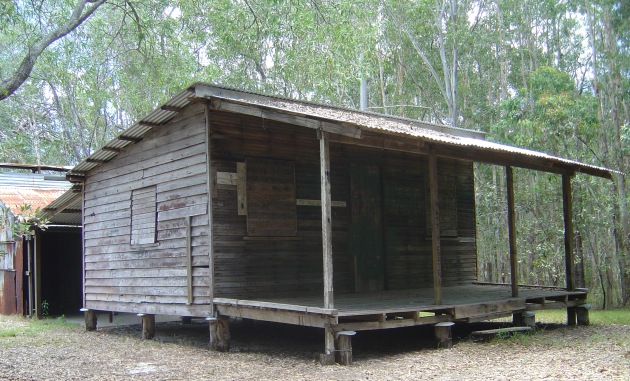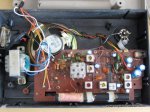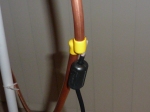Simple FM antennas: Introducing the Half Wave Folded Dipole
September 30, 2014
Cost: From $ 45-75
Length: Approximately 137 cm (54″)
The Half Wave Folded Dipole comprises two elements of typically Aluminum Alloy construction. The Folded Dipole forms the active (or driven) element in a Yagi-Udi array.

Folded dipole for DAB+ bands © 2013 Digitek
How is it used?
This directional antenna is typically mounted ‘broadside’ to the desired transmitter. Experimenters may choose to add additional dipole elements or incorporate reflectors and directors.
How do I buy one?
If looking to purchase one, there are several options:
- Remove this element from an inexpensive FM yagi. Before purchasing a yagi to ‘harvest’, please check with the retailer or manufacturer to ensure that the element can be removed; on some retail FM antennas (including the Matchmaster & Hills three element FM yagis) the folded dipole can NOT be physically detached.
- Rescue Electronics Surplus of Connecticut custom manufactures a ceiling-mounted folded dipole. This antenna is ideal for bedrooms; cost is from $99 with worldwide shipping possible.
- D-lenp of China manufacturers a two element FM yagi with detachable folded dipole. Cost is $25 plus shipping. Five element varieties are also available.
How do I make one?
At the end of this article there are links to Do It Yourself (DIY) antennas that enthusiasts or radio amateurs have constructed with copper tubing for FM broadcast, digital television & even 850 MHz wireless internet reception!
A folded dipole for FM may be constructed with 19 mm (0.75″) square tube aluminium extrusions or even 6, 8 or 10 mm round tube extrusions. The choice of round tubing is recommended. Although one metre (3.3 ft) long extrusions (at several of these diameters) are widely advertised for a few dollars each from a major hardware retailer, it is usually necessary to make a custom cut of the appropriate length.
To determine the required lengths for each of the three sections of the folded dipole, please consult an on-line dipole antenna calculator or a step-by-step guide to FM yagi construction. During October*, a step-by-step DIY project will be published on this blog as part of this series on simple FM antenna building. Readers can easily and inexpensively make their own folded dipole for FM reception from copper tubing.
A potentially easier solution than the use of aluminium or copper tubing is to construct a folded dipole (or a standard single dipole) from copper or aluminium foil tape attached to a round tube PVC pipe. And better still; the total cost is far less than a round of drinks with a few lads at The Local.
Is it suitable for field trips?
Absolutely! (Most antennas are, of course but the lighter and smaller to carry the better!)

Half Wave Folded Dipole & suppression choke in sedan © 2013 FM DXing
How does it perform in the field?
Whenever this writer ventures into the mountains, this antenna is employed since it outperforms the factory monopole in the car. Whilst this antenna design has long been studied using computer modelling by researchers, empirical observations in the field are (hopefully) a bit more colourful for readers!
One of the most rewarding mobile reception achieved with this antenna (above) was rare tropospheric ducting from Nouvelle Caledonie during September of 2013, whilst parked on an unobstructed peninsula (left). Granted, even with a 19 decibel masthead signal amplifier employed in this scenario, these signals were extremely weak! Nonetheless, the bottom line is that the folded dipole antenna offers an enormous potential for any receiving application. (If reading about mobile mountain DX fun previously published on this blog, please remember that the half wave folded dipole antenna was employed on these ‘day trips’ without exception).

Typical DX application with the folded dipole & Degen DE1121 at Harry’s Hut (36 ft / 11 m ASL) © 2014 FM DXing

Harry’s Hut © 2014 FM DXing
In September of 2014, this antenna was used at the insect-ridden Harry’s Hut day-use area (above) situated on the western bank of the upper Noosa River. The folded dipole was hand held vertically by the ‘old man’ (dutifully assisting) a few metres above a park bench (inset, right) a short walk from the jetty and canoe landing facilities (below). As a contrast to the peninsula trip recounted above, nothing is notable about this stop! It is included merely as a typical illustration of mobile FM reception that may be ordinarily expected with this antenna (using a narrow filter modified Degen DE-1121 portable recording receiver).
On this evening (during a ‘quick and dirty’ 15 minute listening window available) there was enjoyable jet-reflected scatter from community radio in Byron Bay (coastal S) to public radio in Rockhampton (inland NW) during flat spring conditions (zero ‘tropo’) comprising a scatter range of 390 mi / 627 km. Even the terrific country narrow caster from Bundaberg was audible.
These signals were NOT audible on the Toyota Prado factory double DIN CD/cassette radio, a quality Japanese DSP receiver. Due to superior design, any contemporary car radio typically exhibits greater sensitivity than its portable radio counterpart. For a portable radio to exhibit such out-performance in the field can be attributed to the use of the folded dipole antenna. Such a comparison seemed fair, since both the vehicular antenna and the portable antenna were operated at the equivalent height above ground. Adjacent channel interference was NOT a determining factor in reception.
Any inexpensive portable receiver that features an external FM antenna jack will accommodate a folded dipole (or loop) FM antenna. These radios include the CR-1100, DE-1103 (KA-1103), DE-1121 (KA-1121), PL-660, PL-606 or PL-310ET from the Tecsun manufacturing parent company. Others include the Digitech AR-1748 (bloggers suggest this may be manufactured by Redsun) or the Sangean ATS-505P, to mention a few current models. An antenna adapter (typically a 3.5 mm audio plug to PAL socket) is required. These are available from $4 from electronics retailers. Make no mistake… this writer believes that purchasing a portable receiver which accommodates an external antenna (and the use of a ‘homebrewed’ or commercially-made external antenna) is worth the extra effort!
What about a wire folded dipole?
The above observations are limited to the ‘metal version’ of the half wave folded dipole. It should be acknowledged that a twin lead wire version of this design is widely available. Whilst physically similar to the wire dipole (left) it differs from that ‘pure’ dipole design by having joined conductors and a 300 ohm impedance. Detailed information on the limitations of wire-based antennas appears in the table and references below.
Terk offer three amplified indoor antennas designed solely for FM reception. Amongst these models, the FMPro is based on a folded dipole design. It is weather proofed for use outside. Rival manufacturer Magnum Dynalab offer the SR-100 Silver Ribbon Tunable antenna.
| ADVANTAGES | DISADVANTAGES |
| Improved Voltage Standing Wave Ratio (VSWR) measurements at the terminals suggest best efficiency over most other simple antennas, including twin lead (ribbon cable) antennas. | More expensive to buy than other simple antennas such as a wire antenna or Rabbit Ears. |
| Wider bandwidth than a single element dipole. (David Jefferies PhD suggests a sensible single dipole may exhibit a 15% fractional bandwidth). Although the folded dipole is still often classified as a narrowband antenna, the wider bandwidth may be considered a favourable attribute for reception on the FM or digital television bands. | May be considered unsightly; beauty is in the eye of the beholder (or ‘beer holder’) of course! |
| Higher directivity than a single element dipole. Because of its directional characteristics, ideal for mobile reception to null strong, unwanted local stations. | Due to higher impedance over a single dipole, requires a balun (usually supplied) if connected to a tuner with a 75 ohm coaxial input only. |
| Ideal for ‘mating’ with a quality masthead pre-amplifier if using a car receiver or component tuner. | Unsuitable for air travel because does NOT fit in standard ports (suitcases). |
| Easily fits in the cabin of the average sedans (including in the boot). | Depending on the size (a function of the wavelength) the copper version may be quite heavy (but effective exercise) if transporting to a summit or forest clearing. |
| Extremely durable; it will probably outlast one’s portable receiver! Significantly better durability than telescoping rod antennas such as Rabbit Ears. | |
| Easily fits in a bedroom for indoor reception near a window. |
As always, the writer has no affiliation with any retail merchant or product manufacturer mentioned. This entry is NOT intended to be construed as an endorsement of any particular product. Prospective buyers should carefully make their own enquiries according to their particular needs and circumstances.
The author wishes to acknowledge the valuable assistance of David in providing his feedback and personal observations of earlier drafts.
Altitude measurements performed with Celestron altimeter calibrated on-site. Calculations performed with Google Earth using ACMA KMZ data.
* Due to abnormally hot & active tropospheric ducting experienced during October & November, the aforementioned copper folded dipole DIY project will now be published (later than originally scheduled) during December in two parts. The writer apologies for the delay in publication.
ANTENNA SUPPLIERS
ANTENNA TUBING V WIRE EFFICIENCY
Rescue Electronics Folded Dipole
ANTENNA MATERIALS
Building antennas from everyday materials
DIY DESIGNS TO BUILD WITH ALUMINIUM TUBING
Copper or aluminium foil tape dipole
Stealth antennas made from conductive foil
DIY DESIGNS TO BUILD WITH ALUMINIUM TUBING
Element diameter considerations
DIY DIPOLES TO BUILD WITH COPPER TUBING
Dave’s off-centre single dipole
850 MHz dipole for Wireless Internet
Single dipole for two metre band amateur radio
VHF high band dipole for Digital TV
VHF high band & UHF dipoles for Digital TV
DIY ANTENNAS TO BUILD WITH COPPER TUBING
189 MHz yagi for Digital Television (includes dipole)
P2P micro-powered FM broadcast antennas used by uni students in Melbourne (2009)















